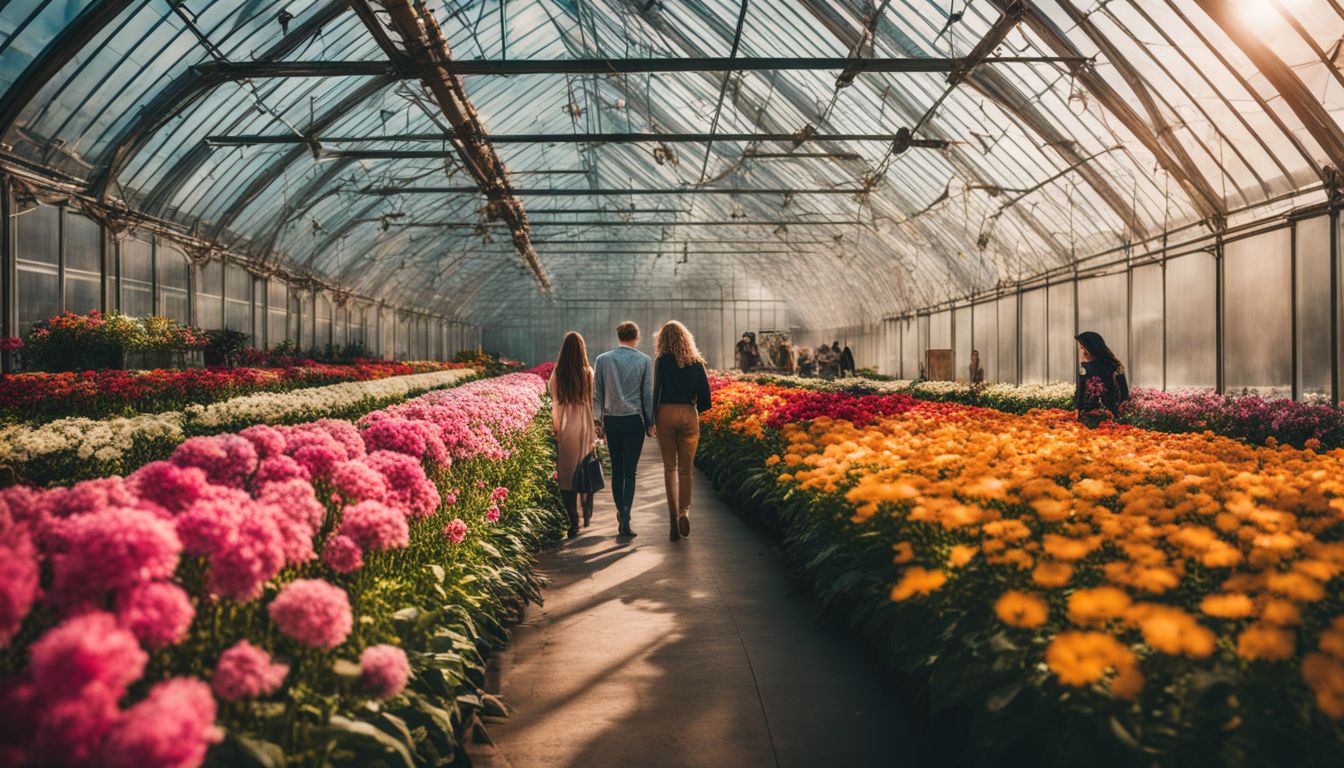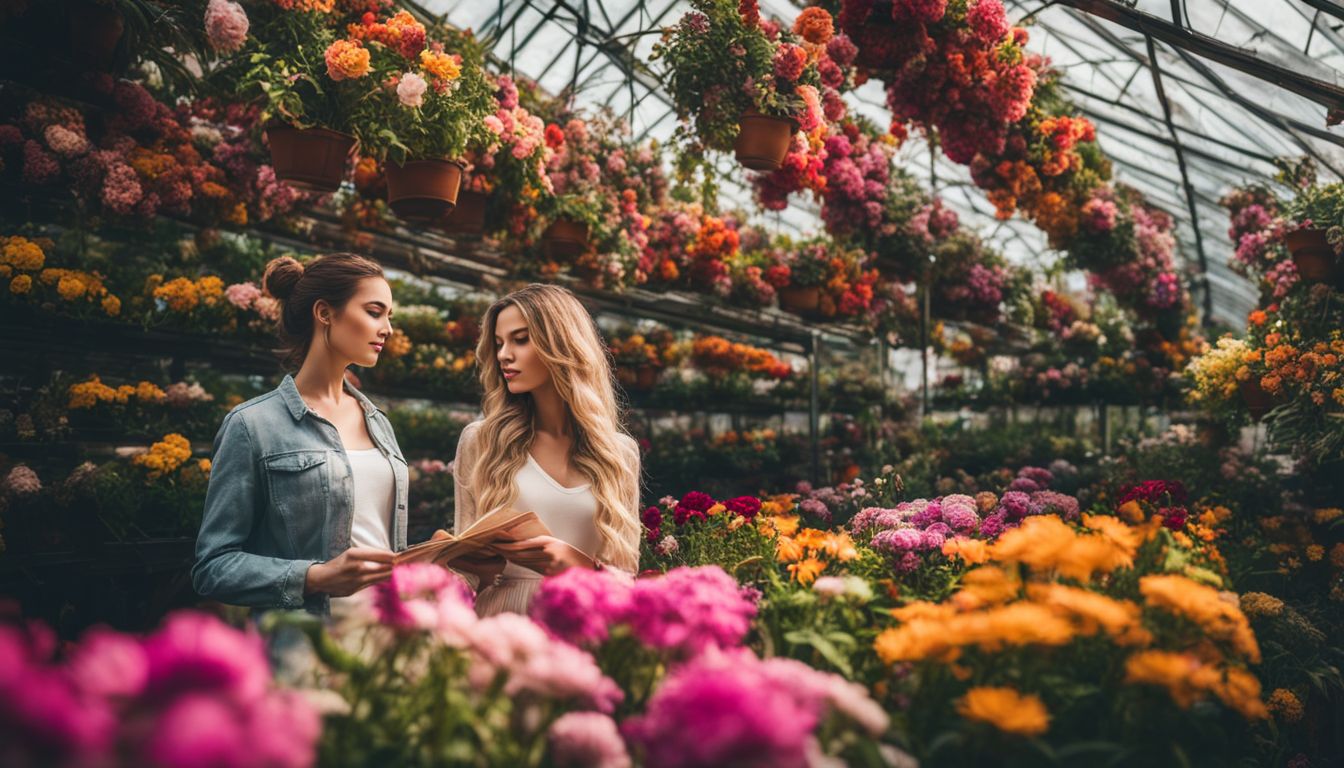Are you a gardening enthusiast looking to add more variety and vibrancy to your green space? Then, it’s time you learned about floriculture – a branch of horticulture that focuses on flowering crops.
This article will guide you through the cultivation and propagation of flowering plants for home gardens or commercial greenhouses, from understanding floricultural science to exploring its future prospects.
Let’s dig deeper into this blooming business!
Key Takeaways
- Floriculture is a part of horticulture that focuses on growing flowering plants for gardens and greenhouses.
- This field uses advanced cultivation systems like greenhouses and hydroponics, along with specific techniques to control temperature, light intensity, and humidity for optimal plant growth.
- Soilless cultivation methods manage soil – borne diseases better and use resources effectively.
- The quality of floricultural products depends largely on proper storage methods, effective packaging solutions, temperature control in the greenhouse, maintaining optimal light intensity using technologies such as LED lighting.
- Continuous flowering helps meet high demand for flowers throughout the year and ensures market stability.
- Flowering plants from floriculture improve urban spaces by introducing living walls or vertical gardens which contribute positively to our environment by absorbing harmful pollutants in the atmosphere.
- Floriculture promotes sustainable agriculture through the use of entomopathogenic fungi that act as natural enemies against pests without relying on chemical pesticides.
Understanding Floriculture and Its Role in Horticulture

Floriculture, a distinct division of horticulture, revolves around the cultivation and propagation of flowering crops. It covers different types of plant products including cut flowers, potted flowering plants, bedding plants along with flowering shrubs and trees for landscaping or garden use.
This branch is much more than just growing beautiful blooms; it forms an integral part of rural economies in several countries worldwide.
The advancement in technology has transformed floriculture into a highly technical field requiring controlled environments such as greenhouses. Greenhouse-grown flowers have several benefits including easing the control over factors like temperature, light intensity and relative humidity which play significant roles in flower production.
In addition to regulated growth conditions, effective propagation techniques are employed in floriculture with practices like using softwood cuttings to propagate pot roses being quite common.
Another widely adopted practice involves the application of rooting hormones combined with fungicide to these cuttings stimulating root growth.
The Science of Floriculture

Diving deep into floriculture unveils a complex science. Detailed cultivation systems, which may include various types of greenhouses or outdoor growing environments, are indispensable for successful plant growth.
Each system employs strategically devised agronomic management techniques to optimize plant health and productivity. These techniques cover everything from controlling light intensity to managing nutrient solutions in soilless cultivation systems, all with the aim of ensuring healthy flowering plants.
The right logistic technologies aid in effectively preserving harvest quality until it reaches its final destination—be it a garden, park or home decor. It is equally crucial to adopt appropriate postharvest strategies for maintaining the freshness and aesthetic appeal of cut flowers and potted plants long after they leave their initial growing environment.
Overall, mastering this intricate science can reap beautiful rewards in form of vibrant blossoms that adorn our surroundings.
Cultivation Systems
Floriculture is rapidly evolving into a high-tech industry that extensively utilizes advanced cultivation systems. The heart of these systems lies in the controlled environments of greenhouses.
These structures accommodate various plants, including cut flowers and potted flowering plants, providing an optimal environment for their growth.
Soilless cultivation systems have risen to prominence in recent years due to their numerous benefits. These hydroponic systems replace traditional soil with nutrient solutions tailored for each plant variety.
This method effectively manages soil-borne diseases and optimizes resource utilization, leading to healthier and more vibrant floricultural products. Alongside such innovation, methods used for controlling temperature, light intensity, and relative humidity within greenhouses have also seen significant upgrades.
Agronomic Management Techniques
Mastering agronomic management techniques propels the success of floriculture.
- Use of softwood cuttings: This popular floriculture method duplicates pot roses efficiently.
- Application of rooting hormones: A combination of fungicide and these hormones stimulates essential root growth.
- Soilless cultivation systems: Instead of traditional soil, a nutrient solution supports plant growth in hydroponic systems.
- Temperature control: Optimal climate conditions foster healthy plant development in greenhouses.
- Light intensity management: By adjusting light levels, growers can influence flowering times and plant morphology.
- Disease control: Effective treatment options combat soil-borne diseases, enhancing crop health and productivity.
- Humidity regulation: Sustaining appropriate levels of relative humidity prevents dehydration and disease spread among plants.
Logistic and Postharvest Strategies
The quality and value of floriculture products heavily depend on logistic and postharvest strategies.
- Proper storage methods are crucial to prolong the life of cut flowers and potted plants.
- The use of hydroponic systems can reduce the risk of soil-borne diseases, eliminating the need for soil disinfection.
- Temperature control within the greenhouse is vital in managing flowering times and ensuring plant health.
- Maintaining optimal light intensity using technologies such as LED lighting boosts photosynthesis, ultimately improving flower yield.
- Regular monitoring and adjustment of relative humidity levels support overall plant development.
- Effective packaging solutions protect delicate blooms during transport, maintaining their visual appearance until they reach end consumers.
- Genetic improvement initiatives can boost flower longevity postharvest by increasing tolerance to environmental stresses.
The Importance of Continuous Flowering in Floriculture

Continuous flowering in floriculture is vital for consistent supply and meeting the high demand of flowers and ornament plants. This relentless production cycle ensures market stability, benefiting both growers and consumers.
Additionally, it broadens the diversity of available varieties, fulfilling each buyer’s unique preference.
Innovative soilless cultivation systems with controlled temperature, light intensity, and relative humidity are commonly used to promote continuous blooming. Hydroponic systems have also gained popularity in modern floriculture due to their effectiveness against soil-borne diseases.
These advanced growth processes combined with efficient postharvest technologies help prolong shelf life thereby bringing more value to this highly competitive industry.
The Role of Floriculture in Landscaping

Floriculture plays a critical role in landscaping, offering myriad benefits from beautifying spaces to improving environmental health. It fosters the design of living walls, which are vertical gardens that enhance urban spaces with lush greenery and blooms.
Perennials play a significant role in such designs due to their long-lasting nature and recurring bloom cycles. Floriculture also promotes biodiversity by introducing a variety of plants into landscaped areas, thereby contributing positively to our ecosystem.
By integrating floriculture into landscaping strategies, we can transform dull urban areas into thriving green spaces teeming with life and beauty.
Design of Living Walls
Living walls, also known as vertical gardens or green walls, are an innovative aspect of floriculture design in landscaping. These visually striking structures utilize advanced technologies to cultivate a variety of flowers and plants on vertically suspended panels.
Through precise control over light spectrum intensities using LED lighting, gardeners can encourage optimal plant growth even in limited spaces. As part of the living wall design process, photoselective films are employed for their ability to manage the properties of light that reach the plants—mimicking greenhouse conditions on a smaller scale.
Furthermore, chitosan enhances these designs by helping protect ornamentals from pests and diseases. In essence, living walls exemplify modern-day horticultural science and aesthetic appeal coalescing seamlessly into practical applications for sustainable urban gardening practices.
Use of Perennials in Living Walls
Living walls have transformed the way people view and create gardens, particularly through the use of perennials.
- Perennials offer a variety of benefits in living walls applications.
- These plants live for more than two years, providing a lasting impact on any landscaping design.
- Floriculture experts cultivate and propagate perennials to maximize these benefits.
- Perennials add aesthetic appeal to indoor and outdoor spaces with their vibrant colors and unique forms.
- They improve air quality by absorbing harmful pollutants in the atmosphere.
- Perennials can also reduce noise levels by acting as natural sound barriers.
- Beneficial insects find habitat within perennial – rich living walls, promoting biodiversity.
- Gardening enthusiasts can employ different species of perennials to create visually stunning living walls throughout the year.
- The sustainable agricultural practices used in floriculture contribute to the healthy growth of perennials in living walls.
- The intersection of floriculture and urban forestry is evident in these vertical gardens that not only display beauty but also promote environmental sustainability.
Floriculture and Sustainable Agriculture: The Use of Entomopathogenic Fungi
Entomopathogenic fungi have become an integral part of sustainable agriculture, contributing significantly to the growth and development of floriculture. These beneficial fungi are natural enemies of pests that pose threats to flowering plants often used in landscapes and gardens.
Their application decreases reliance on chemical pesticides, promoting environmentally-friendly gardening practices.
Researchers like Bamisope Steve Bamisile, Komivi Senyo Akutse, Junaid Ali Siddiqui, and Yijuan Xu are delving deeper into harnessing the potentials of entomopathogenic fungi. Their research explores how these organisms can be effectively implemented into modern cultivation systems for healthier horticultural crops.
This method doesn’t just tackle pest problems; it also addresses soil-borne diseases which tend to affect nutrient solution balance in hydroponic systems.
Striking a perfect balance between temperature control, light intensity and relative humidity is vital in creating the optimal growing environment for these beneficial microorganisms.
It’s a matter of aligning agricultural science with nature’s wisdom for more sustainable flori- and horticultural practices geared towards preserving Earth’s biodiversity while maintaining economic well-being within the agricultural sector.
Current Research Needs and Challenges in Floriculture
Floriculture researchers are striving to explore new areas of study and overcome existing challenges. The genomics of commercial flowers is a nascent field with very limited research conducted so far, hindering innovations in flower type and product development.
Scientists believe that integrating omics studies – genomics, transcriptomics, and metabolomics – could hold the key to creating novel flowers. While these studies have been reported for major commercial flowers like roses, chrysanthemums, gerbera, gladiolus, and carnations there remains much more to be studied about lesser-known yet equally valuable species.
Traditional means of propagation such as softwood cuttings are recognized methods in floriculture but advances must be made to improve effectiveness. For instance, using rooting hormones blended with fungicide on cuttings can stimulate root growth leading to better survival rates among propagated plants.
More advanced technology-wise is micropropagation or in vitro cultivation; however this laborious technique is costly making it less appealing commercially.
Moreover soil-borne diseases represent another hurdle within the discipline requiring attention from researchers’ end along with issues related to temperature control light intensity and relative humidity essential factors for plant growth in greenhouses.
Regardless of these obstacles the scientific community sees splendid potential within floriculture that needs continued exploration adapted methodologies innovative technologies and persistence.
The Intersection of Floriculture and Urban Forestry
Urban forestry and floriculture often interlink within the scope of horticultural science. This cross-pollination creates visually pleasing green spaces in urban settings, effectively improving environmental quality with flourishing trees and flowering plants.
Floriculture contributes vastly to the aesthetic appeal of these areas through its assortment of cut flowers, potted plants, bedding plants, and landscaping trees.
Urban forests enhance air quality by absorbing pollutants while acting as a home for various wildlife species. Simultaneously, floriculture enriches these ecosystems with diverse flowering shrubs that attract pollinators such as bees and butterflies.
The combination of urban forestry and floriculture cultivates biodiversity hotspots right amidst our cities. These interconnected fields not only transform our living environments but also boost economic well-being by providing various non-wood products like seasonal greenery from foliage-based ornamentals.
The Future of Floriculture: Perspectives and Predictions
Emerging technologies and scientific advancements are shaping the future of floriculture. High-tech activities, such as genomics, transcriptomics, and metabolomics lead to new types of flowers and products that will revolutionize the industry.
In addition to genetic science, improvements in greenhouse technology also promise significant changes for the future of floriculture. Innovative photoselective films designed for greenhouse coverings improve plant growth conditions by managing light spectrum control.
LED lighting joins this advancement offering great flexibility in controlling the light spectrum which crucially affects plant development.
Consumer perception regarding genetically modified (GM) ornamental plants is evolving with a mixed outlook but showing some interest to incorporate these unique plants into their gardens.
As we move forward, integrating these technological advances with sustainable practices will elevate floriculture’s role in enhancing economic well-being without compromising our environment’s health.
Final Thoughts
Floriculture shapes our world with vibrant colors and enchanting scents, turning ordinary spaces into extraordinary landscapes. As a discipline of horticulture, its innovative practices guarantee the beauty and health of flowers from greenhouses to gardens.
The science behind floriculture continuously evolves, promising exciting future developments in this field. Indeed, floriculture plays an invaluable role in enriching our environment, aesthetic experiences and economy.
FAQs
1. What is the importance of floriculture in horticulture?
Floriculture plays a vital role in horticulture by cultivating and propagating flowering plants for landscaping, gardens, and greenhouses using traditional culture methods like softwood cuttings, grafting, or cutting–grafting.
2. How do genetic engineering and OMICS contribute to floriculture?
Genetic Engineering and OMICS aid floriculture by enabling breeding techniques that result in a variety of flower species including pot roses, dwarf roses etc., enhancing their pest resistance and increasing production efficiency in commercial flower cultivation.
3. How does light quality affect the growth of flowering plants?
Light quality greatly influences photomorphogenesis—the process through which plants grow and develop forms—in flowering plants where Red light , Far-red light from sources such as Philips lights are used significantly.
4. Can you give an example of innovative technologies used in Floriculture?
Yes! Cell tissue organ culture technique represents an innovative technology employed within Floricuture that enables propagation materials generation offering higher yield potential.
5. What are genetically modified organisms (GMOs)’ roles in Horticultural Crops’ growth?
Genetically modified organisms serve as valuable tools for improving horticultural crops’ productivity while mitigating risks associated with disease or insect infestations; scientists like M.S Saraswathi & S.Backiyarani actively explore GMO’s beneficial applications.
6. How does Chitosan help preserve agricultural commodities?
Chitosan serves as a biocontrol agent instrumental in preserving agricultural commodities—it aids ornamental conservation by maximizing host plant material resistance against fungal infections during commercial flower development.

